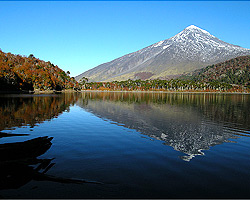 Autor: Mono Andes
Autor: Mono Andes
NATURAL RESOURCES
The park takes its name from the Lanin Volcano, whose permanent snow capped cone passes over 1500 meters to the other peaks in the area, overlooking the mountainous landscape from any angle.
Its geography is also home to 24 beautiful glacial lakes.

The northern half of Lanin National Park, between Lakes Ñorquinco and Huechulafquen, is dominated by the pehuén, which is associated with tambiénse beech and cane colihue.
The monkey puzzle tree is a magnificent columnar conifer tree can reach 45 feet high, topped by a glass of umbrella-shaped form. The densest concentrations are between 900 and 1,800 meters above sea level, in damp and cold.
Its seed is used by many animals and even today remains an important ingredient in the diet of the Mapuche and Creoles in the area. In areas with rainfall exceeding 1,500 mm annually are the Valdivian Rainforest samples. There coihue reached a great development.
The undergrowth is dense, predominantly colihue cane and shrubs such as hawthorn michay and black. Pellín oak forests is another typical formations of this park, with major demonstrations in the north and southwest. Next to him is the raulí, a native tree forest valuable today very restricted and controlled extraction.
The fauna of forest birds has two characteristics: chucao and huet-huet. These are birds walkers, common in colihue cane tangled thickets, where it is easier to see them receive their singing.
Among the common prey of the area include the peregrine falcon, the eagle and the common marsh.
The Pudu, a small deer, and Huillín, an otter exclusive of Argentina and Chile, are two endangered mammals that protects this National Park.
The most picturesque part of aquatic birds is the torrent duck. This is characterized by swimming upstream in flowing streams, looking for insect larvae diving catch deftly turning the stones with his beak. Other ducks present in these environments are the big Gadwall duck glasses.
In lakes birds can be recognized as the huala grebe melancholy voice, the outcropping and flying steamer ducks, black-necked swan, macacitos, kingfishers and red-gartered coot, among others.
Among the exotic salmonid fish predominate planted in the past for sporting purposes. These displaced native fish, such as trout Creole, Patagonian silverside, otuno puyén or catfish and velvety.